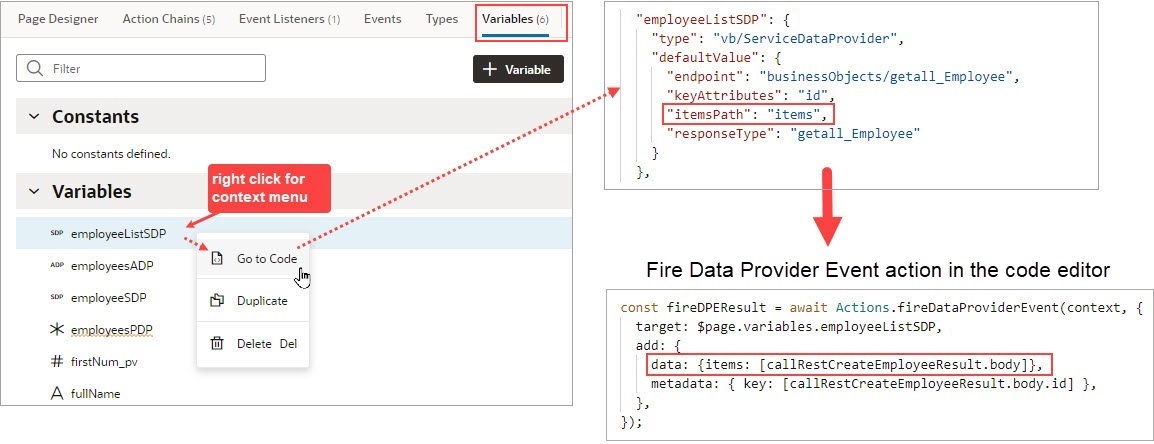Add a Fire Data Provider Event Action
You add a Fire Data Provider Event action to dispatch an event on a data provider in order to reflect changes to your data. For example, a component using a particular Service Data Provider (SDP) may need to display new data because new data has been added to the endpoint used by the SDP.
Note:
This action is not necessary for an Array Data Provider (ADP) variable, since the data array of an ADP variable, exposed via thedata property, can be updated directly using the Assign Variable action. Assigning the data array is automatically detected by VB Studio, and all listeners are notified of this change. Users will be warned of this when the fireDataProviderEvent is used with an ADP, before mutating the data property directly.
For API information about this action, including further details about its properties, see Fire Data Provider Event Action in the Oracle Visual Builder Page Model Reference.
To use a Fire Data Provider Event action:
- Add the action in one of three ways, as explained at the end of Built-In Actions.
- Update the ID field in the Properties pane to make the action more identifiable.
- From the Event Target list, select an existing variable based on a data provider (like
ServiceDataProvider) as the target of the event. If necessary, click Create to create a new data provider variable as the event's target. - Select the type of event you want to dispatch:
- Refresh: Used to show all changes.
- Mutate: Used to specify which changes to show. For example, after a record is deleted, you can use the Mutate option to indicate the deleted record, prompting the UI component bound to the SDP to remove it from the display.
A mutation event can include multiple mutation operations (add, update, remove) as long as the ID values between operations do not intersect. This behavior is enforced by JET components. For example, you cannot add a record and remove it in the same event, because the order of operations cannot be guaranteed.
- If you chose the Mutate event, ensure that the
keyAttributesproperty is set for the SDP variable. The parameters for showing the added, removed, and updated records are under the Add, Remove and Update sections. For the mutate event to perform optimally, here's what's required for each section:- Add: Use the data parameter to pass the added record or records from the add operation’s returned result. If you are using an SDP variable, the structure of the data must match the structure specified by the
itemsPathparameter of the SDP variable’s definition:
Use the keys parameter to pass the key values of the added records with theSet<*>format. Lastly, use the metadata parameter to pass the key values of the added records with the formatArray.<ItemMetadata.<KeyValue>>.For example:data: {items: [callRestCreateEmployeeResult.body],}, keys: [callRestCreateEmployeeResult.body.id], metadata: [{key: callRestCreateEmployeeResult.body.id,}], - Remove: Use the keys parameter to pass the key values of the deleted records with the
Set<*>format. - Update: Same as add.
- Add: Use the data parameter to pass the added record or records from the add operation’s returned result. If you are using an SDP variable, the structure of the data must match the structure specified by the

